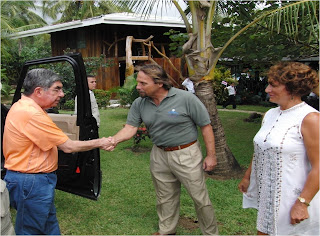Thursday, May 21, 2009
THIS IS SOCIAL SYMBIOSIS
Wednesday, May 20, 2009
THE FLOWER OF THE POCHOTE ...DR. OSCAR ARIAS SANCHEZ

November 24, 2008 . HARMONY MUSIC SCHOOL . POCHOTE
'' I am at a loss of words to describe how moved I felt upon learning of the existence of the Harmony Conservatory on Playa Pochote. The idea of children and youths making their way through the dusty streets, mangroves and fields, by foot or boat, bicycle or horse-back, to attend a school where they may learn to play a musical instrument, practice a sport, or make a painting, filled me with faith in the human spirit. Sometimes the most beautiful flowers grow in the deepest place of the forest, where the trees are thick with thorns.
It is curious that this school be located precisely in Playa Pochote. The pochote tree has always attracted my attention because of its aggressive, thorny bark. It would seem that the pochote tree would scorn the things around it, and would not allow other living things to climb amongst its branches. The thorns that grow on its trunk make me think of the kind of life many of these youths have had to face, a life in where poverty, lack of opportunities and frustration would cause thorns to grow around their hearts, causing them to push away others and build their own separate worlds filled with resentment and pain, like pochote trees that grow side by side without ever touching.,
But if we look beyond the thorny trunk, we will see the birds and squirrels that nest in its branches, the flowers in summer bloom, and the wind that plays amongst its boughs. Then we will see that life is possible despite the thorns, that if we but climb a bit higher and reach a little further, we will find a better reality.
This is what the teachers of the Conservatory have accomplished. They have planted a pochote flower in the hearts of the children. They have brought beauty, joy, life and enthusiasm to a town that is already much different than a few short years ago. They have looked beyond the circumstances, beyond the obstacles. That is the difference between average people and dreamers: most people see the world only as it is, while some see it as it could be. And who can help but dream in the presence of Art?
Even from the estuary that at this beach meets the Pacific, one can envision the contours of the
The more boys and girls get the chance to softly lay their cheek to a violin; the more parents be filled with pride to watch their children playing in an orchestra; the more youths that can experience the discipline involved in art, as well as it miracles, the future of the country will be more just and filled with hope for all."
Tuesday, May 19, 2009
Musicians of the Berlin Philharmonic Want to Continue Supporting the National System of Musical Education and Harmony Music School
from La Nacion Newspaper
Rotary Club Donates Computers

The first step was the internet connection, with wireless capability to connect the Music School to the internet. This is a reality in, thanks to the collaboration of the Costa Rican Electricity Institute (ICE, for its initials in Spanish). As part of the technology outreach program, promoted by Harmony Developments in the community of Pochote, we have received a donation of eight computers by Mr. Walt “Cosmo” Schaefer and the Rotary Club.
English Language Education

Thanks to the collaboration of Peace Corps, and especially of the professor Christine O'Neill, the program of English language education has begun with great success. Approximately 30 students already enjoy this benefit, another tool to assist them in reaching their goals and dreams. The dedication of the profe has been recognized by her students. This has been a great achievement, the product of effort and the hopes of improvement of each of the students. Throughout the year, these students have demonstrated that their dedication is worth the effort.
International Music Camp 2009 at Pochote Beach
This was the best way to begin 2009. Full of music, of talented young people, but above all, of the bonds of camaraderie and friendship. For our boys and girls this encounter was very important for their human and musical growth. The energy that flowed through Pochote in January will be unforgettable for all those that, in one form or another, made this first Pochote International Music Camp (CIM, for its initials in Spanish) possible.
Mangroves, Ocean, and Cellos

“There are those that leave us with profound teachings: the same people who dispense their wisdom. I've been lucky to meet such people along my path. They submerge me in the everyday, affirming me as a habitant of a certain place and time.”
Saturday, May 9, 2009
PRESIDENTIAL COMMITMENT

The visit of President Oscar Arias Sánchez to the community Pochote and to Conservatory Harmony last November strengthened the plans and projects that Harmony Developments developed during 2008.
The dream of a better future for the members of this small costal community on the Peninsula of Nicoya is becoming more of a reality with each passing day. Before us we have a great challenge: to make a model of sustainable development.
Institutions such as BANHIV, the Municipality of Paquera, MINAET and IMAS, have already joined forces with the local Development Association and Harmony Developments to teach the world that it really is possible to develop in Harmony.